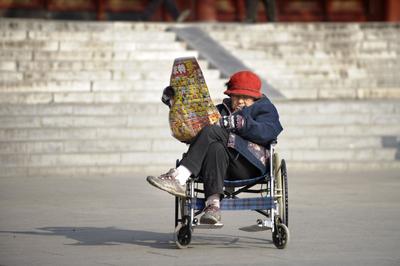China’s high birth rate after 1949, combined with its one-child policy since 1980, means the country is now home to over 200 million people aged over 60. This currently equates to five workers for every retired person, a ratio that by 2035 will fall to just two to one.
Traditions of elderly care in the familial home have in recent times been eroded by urbanisation, birth restrictions and improved workforce gender equality. While investment in the new sector of aged-care homes is increasing, the Chinese government is also looking to charities and existing aged-care networks to fill the looming gap. The World Bank estimates that China has roughly three million aged-care beds, sufficient for just 1.6 per cent of the population over 60. Most of China’s aged population will not in any case be rich enough to afford this level of intensive old-age care.
Confronted by the prospect of a high incidence of poverty among its vast numbers of elderly people, China’s government is rapidly rolling out a voluntary pension scheme. In the past two years alone pension coverage has been extended to approximately 240 million people in rural areas. The system is nascent and is confronted by pressures of breadth and depth of need. Similarly, basic health insurance is being introduced nationwide.
Some challenges of an ageing demography are consistent, regardless of a country’s wealth level. For example, the lack of free hands to care for the elderly is directly related to the extent of ageing and has nothing directly to do with wealth. Also, some related ageing costs are relative to income. Aside from the most expensive capital inputs, healthcare costs are broadly related to income and wage costs. For example, according to their respective national bureaux of statistics, the average monthly wage of a nurse in China in constant 2005 dollars is approximately US$187, while in Japan that wage is more than 10 times higher, at US$2140.
At the macroeconomic level, there is no consistent link between per capita wealth and per capita private or public savings, and thus no automatically available fiscal safety net in rich countries to fund the costs of ageing. To the contrary, in ageing rich countries, long before the costs of the ageing time bomb have peaked, public debt is higher.
Japan is a case in point that getting old after getting rich brings its own set of problems. At a time when Japan has the highest level of public debt in the world, at more than 200 per cent of GDP, its ageing demography enjoys one of the world’s longest life expectancies, but within the context of a below-replacement birth rate and limited immigration.
The conditions of current workers in China and Japan demonstrate a key difference between countries that get old before getting rich and those that get old after getting rich. In China’s case, average wages are rapidly rising, and so current and future workers are expected to be better off than their aged relatives.
In Japan the situation looks very different — and potentially much less economically benign. Japan also has few hands to care for the old, and young people in the labour market are increasingly much worse off than older workers. Older workers retain the conditions of an earlier era of relative wealth, characterised by full-time permanent contracts and salary-related pensions. This is in contrast to the young, who often work part-time or informally and are much less likely to be protected by any kind of permanent full-time contract.
And this situation does not factor in possible pension fund shortfalls, which were reported as amounting to JPY1.11 trillion (US$13.6 billion) in March 2012, an increase of JPY480 billion (US$5.9 billion) from 2011. Pension contracts written during a former demographic boom perhaps failed to account for the future demographic bust in Japan that may have logically been expected to reduce the investment returns applying to the retirement-era of a demographic boom. Coinciding rising wealth and economic capacity in emerging markets compounds the associated investment return uncertainty.
The electoral power of the larger mass of grey voters in Japan and other wealthy democratic countries with elderly populations means the growing convergence of international wages and conditions across most sectors is unlikely to affect the entrenched benefits owing to retirees (that reflect earlier pre-convergence wage levels).
Given the electoral risks of redistributing funds away from older voters, these problems are perhaps better addressed at the international level. As chair of the G20 summit in 2013, Russia may find rare common ground between poor and rich countries by placing the management of ageing populations explicitly on the global economic agenda. Policy ideas could include reconnecting retirees to the active economy by de-linking pensions with the now global inflation rate, and instead effectively linking them to the rate of increase in real wages. Cases of deflation aside, this could more equitably and sustainably empower China’s relatively poor older demographic and Japan’s relatively poor youth alike.
Lauren Johnston is a PhD Candidate at the School of Economics, Peking University.

